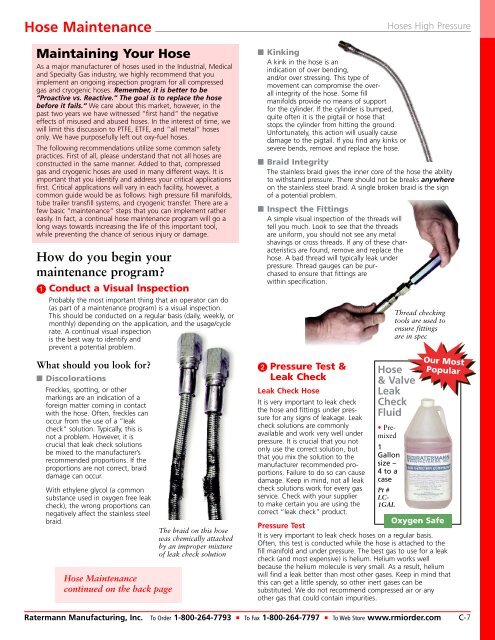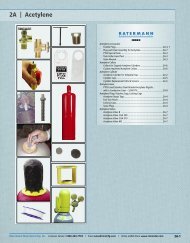Hose Selection Guide - Ratermann Manufacturing Inc
Hose Selection Guide - Ratermann Manufacturing Inc
Hose Selection Guide - Ratermann Manufacturing Inc
You also want an ePaper? Increase the reach of your titles
YUMPU automatically turns print PDFs into web optimized ePapers that Google loves.
<strong>Hose</strong> Maintenance<br />
Maintaining Your <strong>Hose</strong><br />
As a major manufacturer of hoses used in the Industrial, Medical<br />
and Specialty Gas industry, we highly recommend that you<br />
implement an ongoing inspection program for all compressed<br />
gas and cryogenic hoses. Remember, it is better to be<br />
“Proactive vs. Reactive.” The goal is to replace the hose<br />
before it fails.“ We care about this market, however, in the<br />
past two years we have witnessed “first hand“ the negative<br />
effects of misused and abused hoses. In the interest of time, we<br />
will limit this discussion to PTFE, ETFE, and “all metal“ hoses<br />
only. We have purposefully left out oxy-fuel hoses.<br />
The following recommendations utilize some common safety<br />
practices. First of all, please understand that not all hoses are<br />
constructed in the same manner. Added to that, compressed<br />
gas and cryogenic hoses are used in many different ways. It is<br />
important that you identify and address your critical applications<br />
first. Critical applications will vary in each facility, however, a<br />
common guide would be as follows: high pressure fill manifolds,<br />
tube trailer transfill systems, and cryogenic transfer. There are a<br />
few basic “maintenance“ steps that you can implement rather<br />
easily. In fact, a continual hose maintenance program will go a<br />
long ways towards increasing the life of this important tool,<br />
while preventing the chance of serious injury or damage.<br />
How do you begin your<br />
maintenance program?<br />
Conduct a Visual lnspection<br />
Probably the most important thing that an operator can do<br />
(as part of a maintenance program) is a visual inspection.<br />
This should be conducted on a regular basis (daily, weekly, or<br />
monthly) depending on the application, and the usage/cycle<br />
rate. A continual visual inspection<br />
is the best way to identify and<br />
prevent a potential problem.<br />
What should you look for?<br />
■ Discolorations<br />
Freckles, spotting, or other<br />
markings are an indication of a<br />
foreign matter coming in contact<br />
with the hose. Often, freckles can<br />
occur from the use of a “Ieak<br />
check“ solution. Typically, this is<br />
not a problem. However, it is<br />
crucial that leak check solutions<br />
be mixed to the manufacturer’s<br />
recommended proportions. If the<br />
proportions are not correct, braid<br />
damage can occur.<br />
With ethylene glycol (a common<br />
substance used in oxygen free leak<br />
check), the wrong proportions can<br />
negatively affect the stainless steel<br />
braid.<br />
<strong>Hose</strong> Maintenance<br />
continued on the back page<br />
The braid on this hose<br />
was chemically attacked<br />
by an improper mixture<br />
of leak check solution<br />
■ Kinking<br />
A kink in the hose is an<br />
indication of over bending,<br />
and/or over stressing. This type of<br />
movement can compromise the overall<br />
integrity of the hose. Some fill<br />
manifolds provide no means of support<br />
for the cylinder. If the cylinder is bumped,<br />
quite often it is the pigtail or hose that<br />
stops the cylinder from hitting the ground.<br />
Unfortunately, this action will usually cause<br />
damage to the pigtail. If you find any kinks or<br />
severe bends, remove and replace the hose.<br />
<strong>Hose</strong>s High Pressure<br />
■ Braid Integrity<br />
The stainless braid gives the inner core of the hose the ability<br />
to withstand pressure. There should not be breaks anywhere<br />
on the stainless steel braid. A single broken braid is the sign<br />
of a potential problem.<br />
■ Inspect the Fittings<br />
A simple visual inspection of the threads will<br />
tell you much. Look to see that the threads<br />
are uniform, you should not see any metal<br />
shavings or cross threads. If any of these characteristics<br />
are found, remove and replace the<br />
hose. A bad thread will typically leak under<br />
pressure. Thread gauges can be purchased<br />
to ensure that fittings are<br />
within specification.<br />
Pressure Test &<br />
Leak Check<br />
Leak Check <strong>Hose</strong><br />
It is very important to leak check<br />
the hose and fittings under pressure<br />
for any signs of leakage. Leak<br />
check solutions are commonly<br />
available and work very well under<br />
pressure. It is crucial that you not<br />
only use the correct solution, but<br />
that you mix the solution to the<br />
manufacturer recommended proportions.<br />
Failure to do so can cause<br />
damage. Keep in mind, not all leak<br />
check solutions work for every gas<br />
service. Check with your supplier<br />
to make certain you are using the<br />
correct “leak check” product.<br />
• Premixed<br />
1<br />
Gallon<br />
size –<br />
4 to a<br />
case<br />
Pt #<br />
LC-<br />
1GAL<br />
Thread checking<br />
tools are used to<br />
ensure fittings<br />
are in spec<br />
<strong>Hose</strong><br />
& Valve<br />
Leak<br />
Check<br />
Fluid<br />
Our Most<br />
Popular<br />
Oxygen Safe<br />
Pressure Test<br />
It is very important to leak check hoses on a regular basis.<br />
Often, this test is conducted while the hose is attached to the<br />
fill manifold and under pressure. The best gas to use for a leak<br />
check (and most expensive) is helium. Helium works well<br />
because the helium molecule is very small. As a result, helium<br />
will find a leak better than most other gases. Keep in mind that<br />
this can get a little spendy, so other inert gases can be<br />
substituted. We do not recommend compressed air or any<br />
other gas that could contain impurities.<br />
<strong>Ratermann</strong> <strong>Manufacturing</strong>, <strong>Inc</strong>. To Order 1-800-264-7793 ■ To Fax 1-800-264-7797 ■ To Web Store www.rmiorder.com C-7





